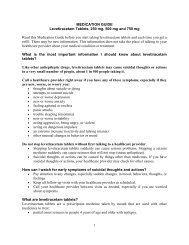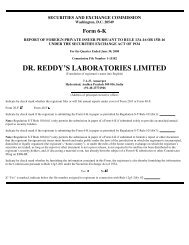DRIVIN G ROWTH - Dr. Reddy's
DRIVIN G ROWTH - Dr. Reddy's
DRIVIN G ROWTH - Dr. Reddy's
You also want an ePaper? Increase the reach of your titles
YUMPU automatically turns print PDFs into web optimized ePapers that Google loves.
152<br />
schedule to the consolidated balance sheet and profit and loss account<br />
Non-refundable up-front and milestone payments (“license fees”), are recognised as revenue when earned, in accordance<br />
with the terms prescribed in the license agreements.<br />
Revenue from the various profit sharing arrangements entered into by the Group is recognised when it is earned and is<br />
measurable and when the ultimate collection is reasonably certain.<br />
Dividend income is recognised when the right to receive the income is established. Income from interest on deposits and<br />
interest bearing securities is recognised on the time proportionate method when the right to receive the income is established.<br />
Export entitlements under the Duty Entitlement Pass Book (“DEPB”) scheme are recognised as revenue when the right to<br />
receive credit as per the terms of the scheme is established in respect of the exports made and where there is no significant<br />
uncertainty regarding the ultimate collection of the relevant export proceeds.<br />
l) Income-tax expense<br />
Current tax<br />
The current charge for income taxes is calculated in accordance with the relevant tax regulations applicable to the Group.<br />
Deferred tax charge or credit reflects the tax effects of timing differences between accounting income and taxable income for<br />
the period. The deferred tax charge or credit and the corresponding deferred tax liabilities or assets are recognised using the<br />
tax rates that have been enacted or substantially enacted by the balance sheet date. Deferred tax assets are recognised only<br />
to the extent there is reasonable certainty that the assets can be realised in future; however, where there is unabsorbed<br />
depreciation or carry forward of losses, deferred tax assets are recognised only if there is a virtual certainty of realisation of<br />
such assets. Deferred tax assets are reviewed as at each balance sheet date and written-down or written-up to reflect the<br />
amount that is reasonably / virtually certain (as the case may be) to be realised.<br />
The break-up of the major components of the deferred tax assets and liabilities as at March 31, 2002 have been arrived at<br />
after setting off deferred tax assets and liabilities where the group has a legally enforceable right to set-off assets against<br />
liabilities, and where such assets and liabilities relate to taxes on income levied by the same governing taxation laws.<br />
m) Earnings per share<br />
The basic earnings per share (“EPS”) is computed by dividing the net profit after tax for the year by the weighted average<br />
number of equity shares outstanding during the year. For the purpose of calculating diluted earnings per share, net profit after<br />
tax for the year and the weighted average number of shares outstanding during the year are adjusted for the effects of all<br />
dilutive potential equity shares. Dilutive potential equity shares are deemed converted as of the beginning of the period, unless<br />
they have been issued at a later date. The diluted potential equity shares have been adjusted for the proceeds receivable had<br />
the shares been actually issued at fair value (i.e. the average market value of the outstanding shares).<br />
n) Employee stock option schemes<br />
In accordance with the Securities and Exchange Board of India guidelines, the excess of the market price of shares, at the date<br />
of grant of options under the Employee stock option schemes, over the exercise price is treated as employee compensation<br />
and amortised on a straight-line basis over the vesting period.<br />
o) Contingencies<br />
Loss contingencies arising from claims, litigation, assessments, fines, penalties etc. are provided for when it is probable that<br />
a liability may be incurred, and the amount can be reasonably estimated.<br />
2. DESCRIPTION OF THE GROUP<br />
DRL is a leading pharmaceutical company, headquartered in Hyderabad, India. The Company’s principal areas of operation are<br />
formulations, active pharmaceutical ingredients and intermediates, generics, diagnostics, critical care and biotechnology, custom<br />
chemical synthesis and drug discovery. The Company’s principal research and development and manufacturing facilities are located<br />
in India with marketing facilities in India, Russia, the United States of America, Brazil and France.<br />
<strong>Dr</strong>. Reddy’s Laboratories Limited, the flagship company of the Group, is listed on the principal stock exchanges in India and on the<br />
New York Stock Exchange (NYSE) in the United States of America.<br />
CONSOLIDATED FINANCIALS | FINANCIALS | ANNUAL REPORT 2001-2002




